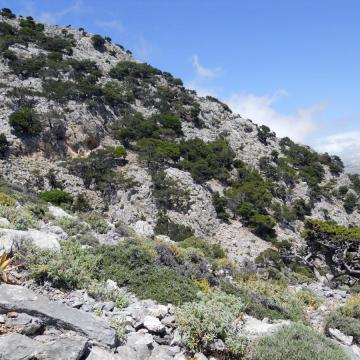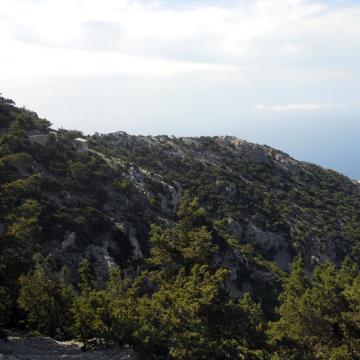GR4310013 - ASTEROUSIA ORI (KOFINAS)
Map
Photos of the site
Quality
A very important site for rare birds of prey, most notably the Lammergeier, the Griffon Vulture and the Lanner Falcon. Significant populations of other raptors like the Golden Eagle, the Bonelli's Eagle and the Peregrine Falcon. One of the most important areas for the Chough whose distribution in Greece is limited. It is also a very important area for the Ruppell's Warbler (one of the largest concentrations of breeding pairs in Greece), the Ortolan Bunting and many more migrant species during spring and fall, including storks and herons. A small population of Monk Seals is also present.
Other characteristics
The site includes the Asterousia Ori massif on southern Crete. The marine area covers less than 1% of the site. The rocks consist mainly of limestones and dolomites, and the lowland eastern area is covered by Neogene sediments. Mount Kofinas, the highest summit (1231 m), is a bare, rugged mountain. At some areas the slopes are covered with pioneer vegetation with Sedum spp. (habitat type 8220).On its southern slopes there are woods with Pinus brutia and small patches of Cupressus sempervirens. The dominant vegetation type is phrygana and there are many areas affected by regular overgrazing by sheep and goats. There are also intermittent streams running down to the sea.There are caves in southern Asterousia, most of them very important from the archaeological view.The coastline is rocky and indended with bays and small capes and numerous caves. Notably, there is a small thicket of Phoenix theophrastii at Agios Nikitas cove (near Achendrias).The marine habitats, posidonia beds and reefs are in excellent condition and monk seals live in the marine caves. There are also many rocky cliffs and gorges. The gorges present continuous changes of landscape, especially Agiofarango gorge (the name literally means the "saint's gorge").
Documentation
- BOURDAKIS, S. 2003. Localization and mapping of breeding areas and colonies of the species: Griffon vulture Gyps fulvus, Black vulture Aegypius monachus, Bearded vulture Gypaetus barbatus, Egyptian vulture Neophron percnopterus, Golden eagle Aquila chrysaetos and Imperial eagle Aquila heliaca in Greece. Technical Report. Hellenic Ornithological Society, Athens. (in Greek)
- BOURDAKIS, S. ALIVIZATOS, H., AZMANIS, P., HALLMANN, B., PANAYOTOPOULOU, M., PAPAKONSTANTINOU, C., PROBONAS, N. ROUSOPOULOS, Y. SKARTSI, D., STARA, K. TSIAKIRIS, R. & XIROUCHAKIS, S. 2004. The situation of Griffon Vulture in Greece. In: The Eurasian Griffon Vulture (Gyps fulvus) in Europe and the Mediterranean. Status report and Action plan. L. Slotta-Bachmayr, R. Bogel, C.A. Camina (Eds.): 48-56. EGVWG.
- DELESTRADE, A. 1998. Breeding and distribution of the populaiton of Cough Pyrrhocorax p. docilis in Aegean Islands and Crete. Unpublished report to NHMC, Un. Of Crete.
Reference: Natura 2000 data form, database release 7 Feb 2014




